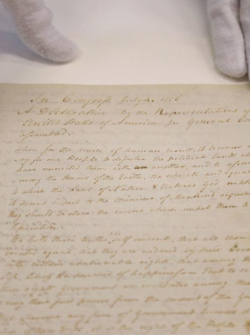Thomas Gilcrease loved his copy of the Declaration of Independence almost to death.
That is why, said Mark Dolph, Curator of history at Gilcrease Museum, this incredibly precious, incredibly fragile document is rarely put on public display.
However, on July 2, and in honor of the 243rd birthday of the United States, Gilcrease Museum will make the only certified, handwritten copy of the Declaration of Independence the centerpiece of its ongoing exhibition, “Masterworks from the Gilcrease Collection.”
It will be the first time the actual document will be seen by the public in four years.
“It will be in central gallery, in a special sealed display case that we’ve had made,” Dolph said. “That gallery contains a number of items such as a portrait of George Washington, (Howard Chandler) Christie’s painting of ‘The Signing of the Constitution,’ the Lincoln death mask, among others.”
The Declaration will be on display only through July 7. Then it will be returned to the special folder that houses the document under several protective layers, and moved back to its permanent home within the Helmerich Center for American Research on the Gilcrease campus — a state-of-the-art chamber under precisely regulated conditions of light, heat and moisture that the Gilcrease staff refers to as “The Holy of Holies.”
It is a far cry from the way Gilcrease himself treated the Declaration, which he purchased in 1949.
A 1954 photograph shows Gilcrease, flanked by young Girl Scouts and Cub Scouts, holding up an equally rare document, a handwritten draft of the Articles of Confederation. One of the Cub Scouts holds the leather document case in which the copy of the Declaration, the Articles and a letter used to be stored.
And for many years, in the 1960s and ’70s, the Declaration, along with other priceless documents from America’s history that Gilcrease had accumulated, were on permanent display, in glass cases that were illuminated by florescent lights whenever a visitor pressed a button on the display.
Read more.
